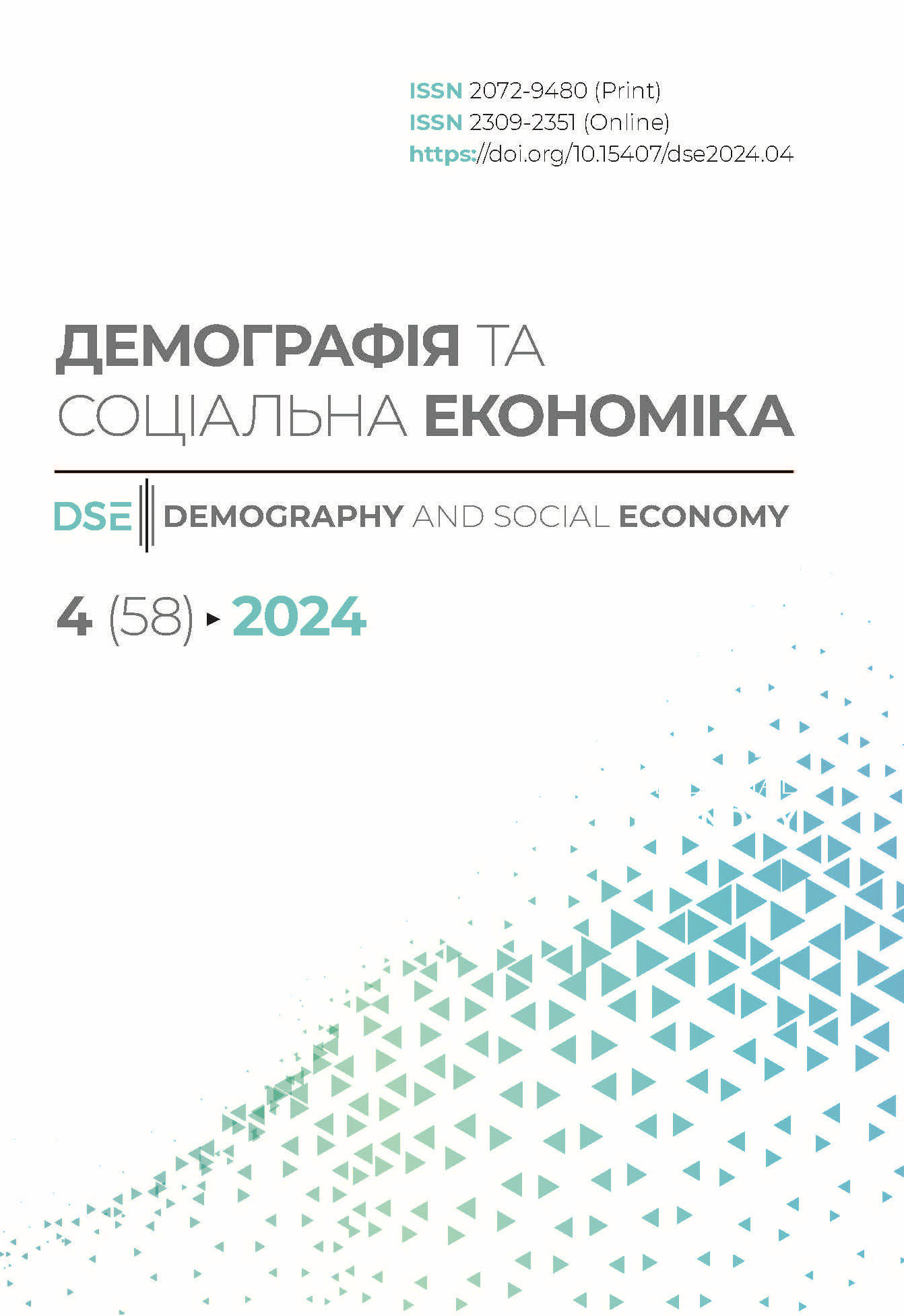RESILIENCE OF THE SOCIO-ECONOMIC SYSTEM OF UKRAINE TO THE SHOCKS CAUSED BY THE WAR: SPECIFICS OF FORMATION AND RESPONSE
DOI:
https://doi.org/10.15407/dse2024.04.003Keywords:
resilience, war-related shocks, aspects of resilience, measuring and forecasting risks and opportunities, actors and instruments, role of households in socio-economic resilience during warAbstract
The full-scale aggression of the Russian Federation has caused a number of fundamentally new shocks for Ukraine, which it had neither economic nor time resources to adapt to. The ability to anticipate possible attacks, quickly recover from shocks and adapt to the new reality (constant bombardment, destruction of housing, lack of electricity, mobilisation, lack of convenient transport links with other countries, etc.) has become critical.
The strength and nature of war shocks determine new methods and tools for their prediction and measurement, which is extremely difficult in the context of the inevitable limitation of information, both comprehensive and selective, during war. In such circumstances, measuring the actual state of the system after the shock has started relies on models and big data, while assessment and forecasting, primarily ex ante, relies on monitoring, including defined development trajectories.
Determining possible responses to the effects of shocks requires clarifying the main aspects of the formation and implementation of resilience (natural resource, economic, demographic, socio-psychological), taking into account their interrelationships and different rates of change, powers and capabilities of individual governance actors (supranational, national, local, and personal), including the specific role of household resources and their consumption behaviour.
Of particular importance is the scale of the system and the appropriate response tools, the focus on mono- or multi-subject governance, coordination mechanisms, and the formality/informality of institutions. In particular, in Ukraine, informal institutions, mainly at the local level (territorial defence, volunteer movement, etc.), have proved to be very important.
REFERENCES
- Bruneau, M., & Reinhorn, A. (2006). Overview of the Resilience Concept. Proceedings of the 8th US National Conference on Earthquake Engineering, 18—22. https://api.semanticscholar.org/CorpusID:39468936
- Béné, C., Wood, R. G., Newsham, A., & Davies, M. (2012), Resilience: New Utopia or New Tyranny? Reflection about the Potentials and Limits of the Concept of Resilience in Relation to Vulnerability Reduction Programmes. IDS Working Papers, 1—61. https://doi.org/10.1111/j.2040-0209.2012.00405.x
- Keck, M., & Sakdapolrak, P. (2013). What Is Social Resilience? Lessons Learned and Ways Forward. Erdkunde, 67 (1), 5—19. http://www.jstor.org/stable/23595352. https://doi.org/10.3112/erdkunde.2013.01.02
- ECR2 Economic Crisis: Resilience of Regions, Final Report (2014). EPSON. European https://archive.espon.eu/sites/default/files/attachments/Scientific_report.pdf
- Navracsics, T., Sucha, V., Wahlstroem, M. et. al. (2015). The Challenge of Resilience in a Globalised World. Publications Office of the European Union. https://doi.org/10.2788/010872 (print), https://doi.org/10.2788/771635 (online).
- Gherghina, S., Volintiru, C., Stefan, G., & Agachi, A. (2022). Understanding Local Re silience: Definitions, Dimension, and Measurement. Research Report, October 2021. ASPEN Institute, Romania. https://locres.eu/wp-content/uploads/2022/02/Raport-Oct-21_logo.pdf
- Carlson, J. L., Haffenden, R. A., Bassett, G. W., Buehring, W. A., Collins, III, M. J., & Folga, S. M. et al. (2012). Resilience: Theory and Application. United States. https://doi.org/10.2172/1044521
- Masik, G. (2023). The concept of resilience: Dimensions, properties of resilient systems and spatial scales of resilience. Geographia Polonica, 95 (4), 295—310. https://doi.org/10.7163/GPol.0237
- Manca, A. R., Benczur, P., & Giovannini, E. (2017). Building a Scientific Narrative Towards a More Resilient EU Society. Part 1: A Conceptual Framework. Joint Research Centre, European Commission. Р. 3, 8. https://doi.org/10.2760/635528
- Demographic Resilience Programme for Europe & Central Asia (2020). UNFPA Eastern Europe & Central Asia Regional Office. https://eeca.unfpa.org/en/publications/demographic-resilience-programme-europe-central-asia
- Investing in women’s rights to build demographic resilience (2024). China Daily. https://www.chinadaily.com.cn/a/202208/24/WS63057ca0a310fd2b29e73e97.html
- Squires, R., & White, I. (2019). Resilience and housing markets: Who is it really for? Land Use Policy, 81, 167—174. https://doi.org/10.1016/j.landusepol.2018.10.018
- Timofiy Mylovanov (2024). https://www.facebook.com/story.php?story_fbid=2917958245040005&id=100004775745586&mibextid=WC7FNe&rdid=F5zGicvR3y1zcL0h
- National Research Council (2012). Disaster Resilience: A National Imperative. Washington, DC: The National Academies Press. https://doi.org/10.17226/13457
- Clark-Ginsberg, A. et al. (2020). Practitioner approaches to measuring community re silience: The analysis of the resilience of communities to disasters toolkit. International. Journal of Disaster Risk Reduction, 50, 1—10. https://doi.org/10.1016/j.ijdrr.2020.101714
- Libanova, E., & Romaniuk, S. (2023). Conceptualization of multi-subject management in social relations. Demography and social economy, 3(53), 33—53. https://doi.org/10.15407/dse2023.03.033 [in Ukrainian].
- Peters, B. G. (2014). Is governance for everybody? Policy and Society, 33 (4), 301—306. https://doi.org/10.1016/j.polsoc.2014.10.005
- Simon, H. A. (1976). Administrative Behavior. A Study of Decision-Making Process in Administrative Organization, Third Edition, The Free Press, Collier Macmillan Publishers, London, UK.
- Davoudi, S., Evans, E., Governa, F., & Santangelo, M. (2008). Territorial Governance in the Making. Approaches, Methodologies, Practices. Boletin de la A.G.E., 46, 33—52.
- North, D. C. (1990). Institutions, Institutional Change and Economic Performance. Cambridge University Press. https://doi.org/10.1017/CBO9780511808678
- Van Assche, K., Beunen, R., & Duineveld, M. (2014). Formal/Informal Dialectics and the Self-Transformation of Spatial Planning Systems: An Exploration. Administration & Society, 46 (6), 654—683. https://doi.org/10.1177/0095399712469194
Downloads
Published
How to Cite
Issue
Section
License
Copyright (c) 2024 PH «Akademperiodyka» of the NAS of Ukraine

This work is licensed under a Creative Commons Attribution-NonCommercial-NoDerivatives 4.0 International License.


